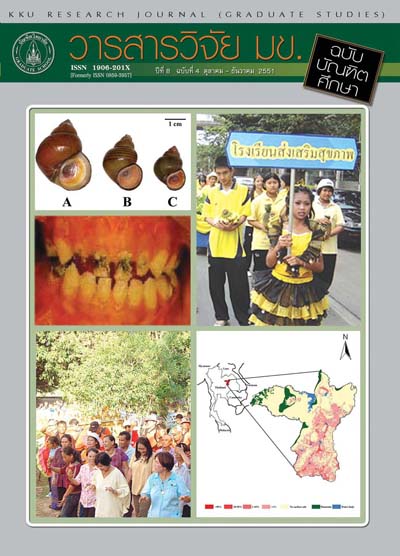Health Profile of Older People in an Elderly Residential Apartment, P. R. China(ภาพสุขภาพของผู้สูงอายุที่พักอาศัยในสถานที่พักผู้สูงอายุแห่งหนึ่ง ในสาธารณรัฐประชาชนจีน)
Keywords:
Health profile(สุขภาพ), Older people(ผู้สูงอายุ), Elderly residential apartment(สถานที่พักผู้สูงอายุ)Abstract
This cross-sectional descriptive study aimed to describe health profile of older people living in an elderly residential apartment in capital city NanNing, GuangXi Autonomous Region, P. R. China. A census population of 351 older people was used to achieve minimum data set of the health profile of older people living in an elderly residential apartment. Data were collected using questionnaires and standard assessment tools. Data was analyzed by descriptive statistics using the software of Statistical Package for Social Sciences (SPSS). Results: 1) Demographic characteristics: Of 351 older people, majority of them were female (63.8%), aged 70 -79 yrs. (44.4%), and were widow (72.1%). Approximately 51.9% of older people had education at high school level; 2) Physical health: Of 351 older people, only 281 elders could answer the interviews verbally. Results showed that 39.6% of elders perceived their general health status as fair. Of 351 older people, 74.4% had history of hospitalization and 24.2% had operation. The symptoms reported were: pain (20.8%), mood change (12.3%), fatigue and weakness (10.3%), and vertigo (10.0%). The diseases found were: hypertension (54.1%), stroke (29.6%), and dementia (24.5%). Geriatric problems found were: mobility problem (34.8%), urinary incontinence (24.8%), memory loss (23.9%), fecal incontinence (23.4%), and visual problem (20.8%). Among eight health behaviors, only 5.4% of older people attended social activities, 6.6% had physical check up, and 21.7% had exercise, regularly; 3) Physical function: Of 351 older people, 36.5% were mild-ADL dependent, and 34.2% were severe-ADL dependent. The most affected IADL among 166 (47.3%) older people were: money management (16.8%), meal preparation (14.2%), laundry (13.7%), and so on; 4) Psychological function: Of 178 (50.7%) older people, 61 (17.4%) were identified as dementia. Of 171 (48.7%) older people, 15.1% had mild depression, and 4.8% had severe depression. This survey provided base line data on the health profile of institutionalized older people. There is the need to conduct cohort study of health profile of older people in order to monitor health and well-being of older people in long term care settings.
การศึกษาเชิงพรรณนา โดยวิธีการสำรวจแบบภาคตัดขวางนี้ มีวัตถุประสงค์เพื่ออธิบายภาพสุขภาพของผู้สุงอายุที่พักผู้สูงอายุแห่งหนึ่ง ในเมืองหนานหนิง เขตมณฑลกวางสี สาธารณรัฐประชาชนจีน ศึกษาชุกข้อมูลขนาดเล็กของผู้สูอายุทุกคน รวม 351 คนที่อาศัยอยู่ในสถานที่พักผู้สูงอายุในระหว่างการเก็บรวบรวมข้อมูล ซึ่งใช้แบบสอบถามที่พัฒนาขึ้นและใช้เครื่องมือประเมินมาตรฐาน วิเคราะห์ข้อมูลโดยใช้สถิติเชิงพรรณา ด้วยโปรแกรมการวิเคราะห์สถิติทางสังคมศาสตร์(SPSS)ผลการศึกษามีดังนี้ 1)ลักษณะของประชากร จากผู้สูงอายุทั้งหมด 351 คนพบว่าส่วนใหญ่เป็นหญิง(ร้อยละ 63.8)อยู่ในกลุ่มสูงอายุปานกลาง(70-79ปี) (ร้อยละ 44.4) และมีสถานภาพสมรส เป็นหม้าย(ร้อยละ 72.1)จบการศึกษาระดับมัธยมศึกษา(ร้อยละ 51.9) 2)ภาพสุดท้ายด้านร่างกาย จากผู้สูงอายุจำนวน351 คนมีเพียง 281 คนที่สามารถตอบคำถามในส่วนนี้ได้ ซึ่งพบว่า ผู้สูงอายุร้อยละ 39.6 รับรู้ว่าตนเองมีภาวะสุขภาพในระดับปานกลางและจากผู้สูงอายุ 351 พบว่าร้อยละ 74.4 มีประวัติเคยเข้ารักษาพยาบาลและร้อยละ24.2 เคยได้รับการผ่าตัด สำหรับอาการที่พบได้บ่อยคือ มีอาการปวด(ร้อยละ 20.8)อารมณ์เปลี่ยนแปลง(ร้อยละ 12.3) อ่อนเพลียและเหนื่อยล้า(ร้อยละ 10.3) และวิงเวียน(ร้อยละ10.0)ด้านโรคและความเจ็บป่วยที่พบ คือ ความดันโลหิตสูง(ร้อยละ 51.4)โรคหลอดเลือดสมอง(ร้อยละ 29.6)และภาวะสมองเสื่อม(ร้อยละ24.5)ด้านอาการสำคัญในผู้สุงอายุพบมีปัญหาการเคลื่อนไหว(ร้อยละ 34.8)กลั้นปัสสาวะไม่ได้ (ร้อยละ 24.8)หลงลืม(ร้อยละ23.9)กลั้นอุจจาระไม่ได้(ร้อยละ23.4) และปัญหาทางสายตา(ร้อยละ20.8)ด้านพฤติกรรมสุขภาพประจำ(ร้อยละ 6.6) และออกกำลังกายสม่ำเสมอ(ร้อยละ21.7) 3)ด้านการทำหน้าที่ทางร่างกาย จากผู้สูงอายุ 351 คนพบว่ามีภาวะพึ่งพาระดับน้อยร้อยละ 36.5 และภาวะพึ่งพาระดับมากร้อยละ 34.2 กิจวัตรประจำวันที่ผู้สูงอายุ 166 (47.3%) ได้รับผลกระทบมากตามลำดับคือการจัดการด้านการเงิน (16.8%) การเตรียมอาหารด้วยตนเอง (14.2%) การซักเสื้อผ้า (13.7%) และอื่นๆ และ4) ด้านการทำหน้าที่ทางจิตใจ จากผู้สูงอายุ178 พบว่ามี61 คน (ร้อยละ 17.4)อยู่ในเกณฑ์มีภาวะสมองเสื่อมและจากผู้สูงอายุ171 คน (ร้อยละ 48.7)พบว่าร้อยละ 15.1 มีภาวะซึมเศร้าในระดับน้อยและร้อยละ 4.8 มีภาวะซึมเศร้าในระดับมาก การศึกษาโดยการสำรวจนี้ ทำให้ทราบข้อมูลพื้นฐานของภาพสุขภาพของผู้สูงอายุที่พักอาศัยในสถานที่พักผู้สูงอายุ ซึ่งมีความจำเป็นต้องศึกษาวิจัยภาพสุขภาพในระยะยาวเพื่อติดตามสถานะสุขภาพและความผาสุกของผู้สูงอายุที่อาศัยในสถานดูแลระยะยาวต่อไป



